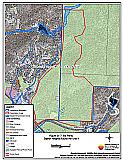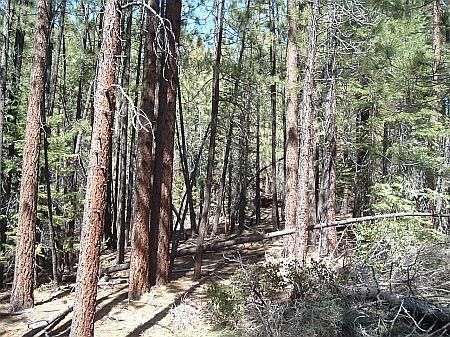Risk/Hazard Identification and Mitigation Project Worksheet
Name of Community: Elk Point/Zephyr Heights/Round Hill
Date: July, 2004
Project Title: Elk Point/Zephyr Heights/Round Hill Unit 4 - Thinning and Brush Removal
Description of Risk/Hazard: Describe in detail the risk or hazard that poses a threat to the community.
Vegetative Fuel and Topography: Second growth stand of Jeffrey pine with some white fir, incense cedar, and a brush understory, located along the eastern edge of the Round Hill residential area. A fire in this area could extend into the residential area. Slopes in the unit vary from 5-60%.
Worst Case Scenario / Hazard: An ignition from the highway or below on a high hazard day with high winds off the Lake would be pushed by wind and topography into the residential community.
Priority Ranking: What is the priority ranking of this risk/hazard in relation to all others identified?
Because most fuels are not below and on the windward side of the community, this project ranks as #9 for the TDFPD.
Location: Describe or attach a map with sufficient detail to allow accurate ground location.
South and West of the Round Hill neighborhood. See Figure 11-7.
Recommended Mitigation Measures and Scope of Work: Present prescription and work specifications in sufficient detail to facilitate procurement of bids and quotes. For hazardous fuel removal projects include estimated volumes (tons/acre) of fuel removed and disposal plan.
Remove or thin brush understory to decrease fire intensity and reduce ladder fuels. Spacing between remaining bushes should be 2-3 times the height of brush. A brush masticator or “Bull Hog” could be used where slopes are 30% or less. Grind the brush and leave as mulch, or hand cut, pile, and burn. Use of herbicide could reduce sprouting of some species. Thin from below, removing smaller trees and leaving larger ones to achieve the desired stocking rate of 80 to 100 square feet of basal area per acre.
*Prescribed fire could be used to reduce the brush understory, and desired where feasible to return fire to the landscape. It should only be applied in areas after thinning and slash pile burning are complete to maintain fire control.
Evaluation of the Extent to Which Completion of This Project Will Reduce the Fire Threat:
Treatment in this area will help contain human-caused ignitions in the residential area near the project area, keeping fire from spreading uphill and becoming uncontrollable. It will also protect the private and commercial structures from a downslope fire event. Implementation of the prescription will reduce the competition among residual trees, increasing forest health and decreasing tree mortality. This will reduce the amount of accumulated dead and down material contributing to the fuel loadings on the forest floor and reduce the chance of a ground fire becoming a crown fire. The prescription will also increase the chance of a crown fire in untreated areas (eastside) dropping to the ground and becoming easier to control.
If all of the recommendations in this report are implemented, there is still no guarantee that a devastating wildfire will not occur in the area. However, community awareness and individual attention to fuels management on private property and fuel reduction on state, federal, and county property will help to achieve the highest level of wildfire safety possible.
Identification of Protected Species or Other Critical Resources: Describe any measures that must be taken to protect critical wildlife habitat, historic
Environmental compliance measures must be implemented before project initiation. Stream Environment Zones are located in the project area and must be protected, employing appropriate TRPA mitigation measures.
Some threatened and endangered species exist in the Tahoe Basin. Appropriate avoidance and mitigation measures should be employed during project implementation.
Compliance with cultural resource protection may also be necessary. Check with TRPA and the NVSHPO to ensure cultural resources are protected.
Post-project Rehabilitation: Present scope of work in sufficient detail to facilitate procurement of bids and quotes.
Rehabilitate any fire control lines, landings or disturbed areas. Rehabilitation will be minimal if only hand methods are used. Where soil has been disturbed, TRPA rehabilitation measures and Best Management Practices would apply. This could include reseeding or mulching areas if necessary.
Estimated Timeline:
Desirable time of year to complete:
May - December
Estimated time required to complete project:
Two operational seasons.
Estimated Cost: Present an estimate of the total cost of project completion and the basis for the estimate presented. If the project can be subdivided into phases or various components, present an estimated cost for each.
| Mechanical Treatment (Slopes <30%): | $1750.00/acre for 160 acres | |
| Hand cut, pile and burn (Slopes >30%): | $2000.00/ acre for 125 acres | |
| Prescribed fire: | $2,000/acre (USFS) for 285 acres | |
| Total Cost | $1,100,000 |
Biomass to be removed is approximately 32 tons/acre
Project Maintenance Requirements:
Conduct a prescribed fire within five years after treatment by hand cutting, piling and burning area. Re-treat with prescribed fire every ten years to control the growth of brush and small trees in the understory.
Other Considerations: Describe any other considerations that must be taken into account to successfully complete this project such as permits, clearances, approvals, etc.
- USFS - Regional Approval
- TRPA - Approval, SEZ clearance
- US Army Corps of Engineer 404 permit
- Air Quality Permit
Figure 11-7Proposed Prescription Area Elk Point/Zephyr Heights/Round Hill Unit 4 |
 |

